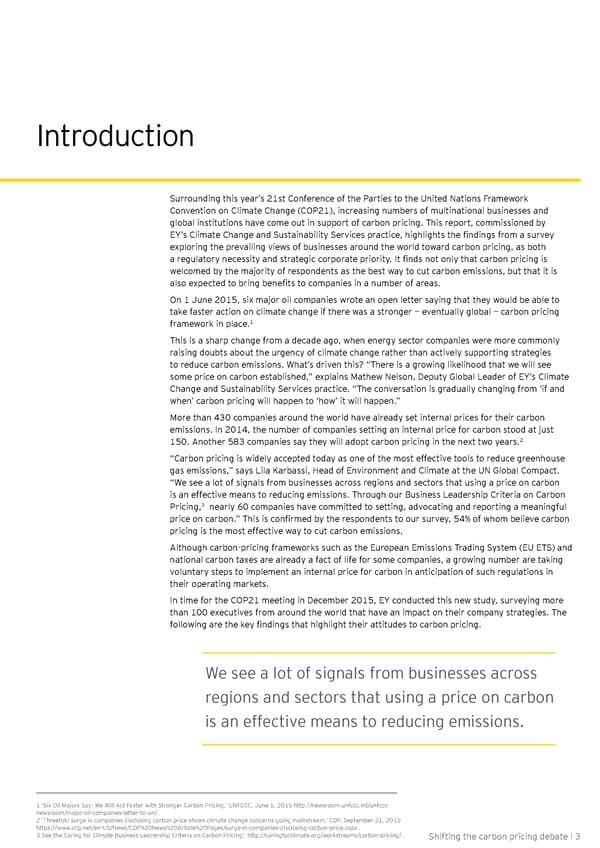Introduction Surrounding this year’s 21st Conference of the Parties to the United Nations Framework Convention on Climate Change (COP21), increasing numbers of multinational businesses and global institutions have come out in support of carbon pricing. This report, commissioned by EY’s Climate Change and Sustainability Services practice, highlights the findings from a survey exploring the prevailing views of businesses around the world toward carbon pricing, as both a regulatory necessity and strategic corporate priority. It finds not only that carbon pricing is welcomed by the majority of respondents as the best way to cut carbon emissions, but that it is also expected to bring benefits to companies in a number of areas. On 1 June 2015, six major oil companies wrote an open letter saying that they would be able to take faster action on climate change if there was a stronger — eventually global — carbon pricing 1 framework in place. This is a sharp change from a decade ago, when energy sector companies were more commonly raising doubts about the urgency of climate change rather than actively supporting strategies to reduce carbon emissions. What’s driven this? “There is a growing likelihood that we will see some price on carbon established,” explains Mathew Nelson, Deputy Global Leader of EY’s Climate Change and Sustainability Services practice. “The conversation is gradually changing from ‘if and when’ carbon pricing will happen to ‘how’ it will happen.” More than 430 companies around the world have already set internal prices for their carbon emissions. In 2014, the number of companies setting an internal price for carbon stood at just 150. Another 583 companies say they will adopt carbon pricing in the next two years.2 “Carbon pricing is widely accepted today as one of the most effective tools to reduce greenhouse gas emissions,” says Lila Karbassi, Head of Environment and Climate at the UN Global Compact. “We see a lot of signals from businesses across regions and sectors that using a price on carbon is an effective means to reducing emissions. Through our Business Leadership Criteria on Carbon Pricing,3 nearly 60 companies have committed to setting, advocating and reporting a meaningful price on carbon.” This is confirmed by the respondents to our survey, 54% of whom believe carbon pricing is the most effective way to cut carbon emissions. Although carbon-pricing frameworks such as the European Emissions Trading System (EU ETS) and national carbon taxes are already a fact of life for some companies, a growing number are taking voluntary steps to implement an internal price for carbon in anticipation of such regulations in their operating markets. In time for the COP21 meeting in December 2015, EY conducted this new study, surveying more than 100 executives from around the world that have an impact on their company strategies. The following are the key findings that highlight their attitudes to carbon pricing. We see a lot of signals from businesses across regions and sectors that using a price on carbon is an effective means to reducing emissions. 1 ‘Six Oil Majors Say: We Will Act Faster with Stronger Carbon Pricing,’ UNFCCC, June 1, 2015 http://newsroom.unfccc.int/unfccc- newsroom/major-oil-companies-letter-to-un/. 2 ‘Threefold surge in companies disclosing carbon price shows climate change concerns going mainstream,’ CDP, September 21, 2015 https://www.cdp.net/en-US/News/CDP%20News%20Article%20Pages/surge-in-companies-disclosing-carbon-price.aspx . 3 See the Caring for Climate Business Leadership Criteria on Carbon Pricing: http://caringforclimate.org/workstreams/carbon-pricing/ . Shifting the carbon pricing debate I 3
 Shifting the Carbon Pricing Debate Page 2 Page 4
Shifting the Carbon Pricing Debate Page 2 Page 4